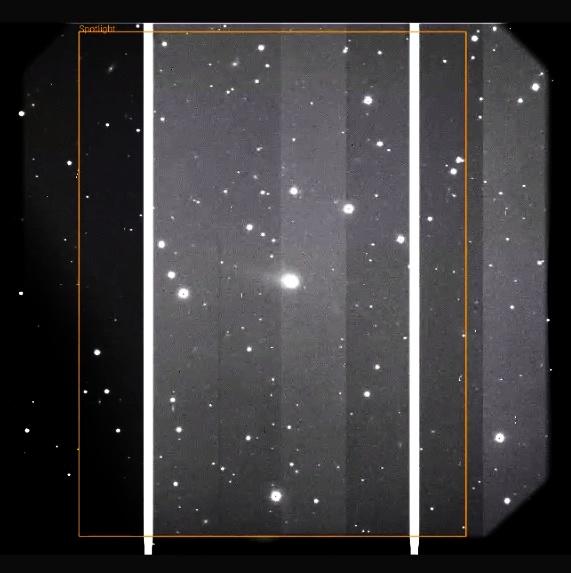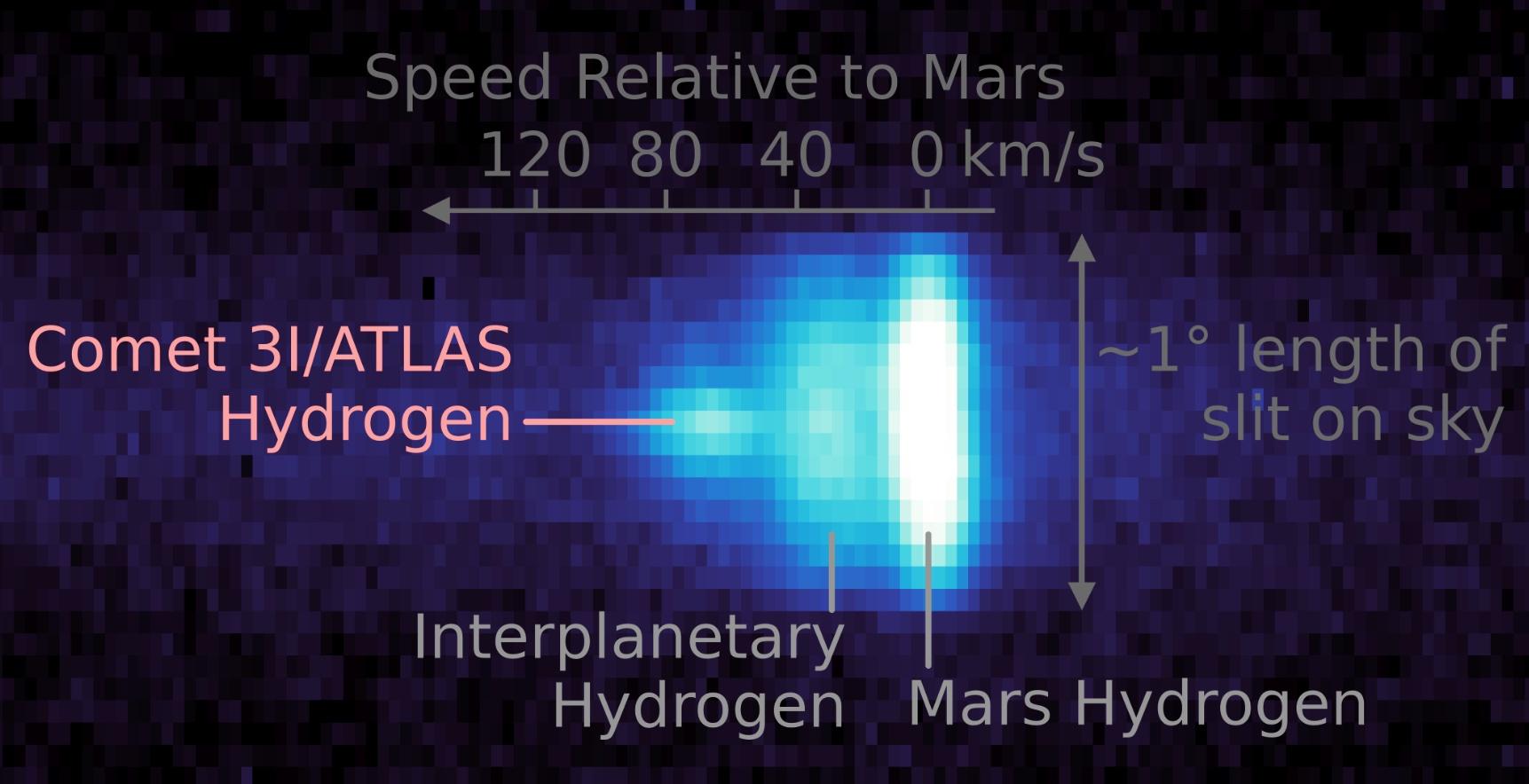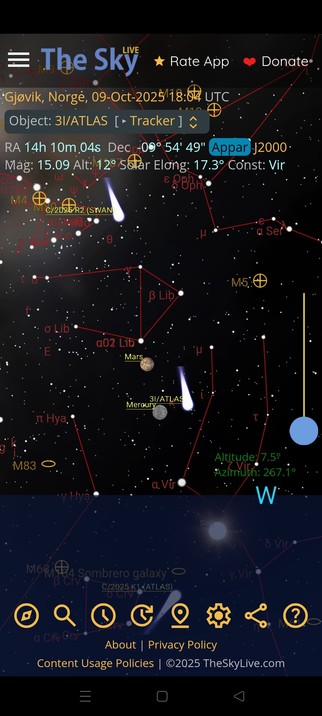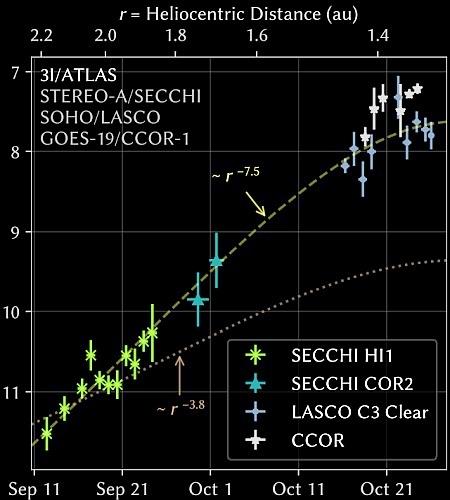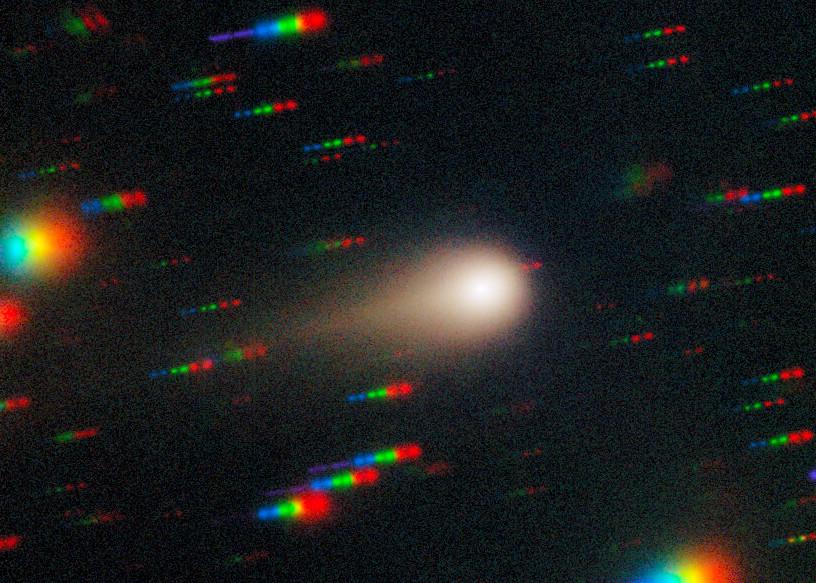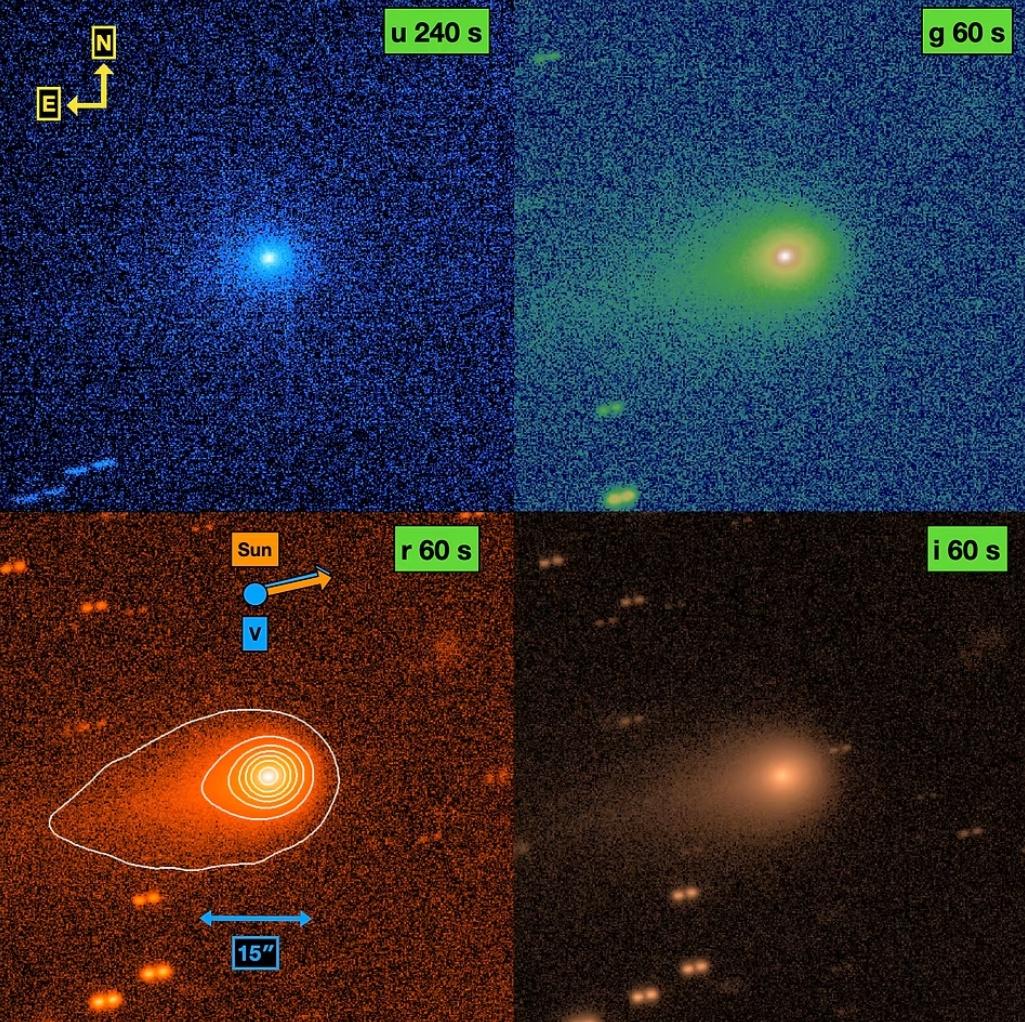Astronomers have categorized this object as interstellar
because of the hyperbolic shape of its orbital path.
(It does not follow a closed orbital path about the Sun.)
3I/ATLAS will reach its closest point to the Sun around Oct. 30, 2025,
at a distance of about 1.4 au
(130 million miles, or 210 million kilometers)
— just inside the orbit of Mars.
Keine Außerirdischen: NASA zeigt Bilder von 3I/ATLAS
Nach dem Ende des Shutdowns hat die NASA endlich Bilder des Kometen 3I/ATLAS gezeigt. Das lange Schweigen der Raumfahrtbehörde hatte zu Spekulationen geführt.
https:…
Whoa, the #InterstellarComet 3I/ATLAS clearly has a tail now! A raw image taken minutes ago with the GMOS instrument on Gemini South and shared live during the Shadow the Scientists event - I raised the contrast slightly.
Astronomie: ESA-Missionen fotografieren 3I/ATLAS, die der NASA vielleicht auch
Der interstellare Komet 3I/ATLAS hat den Mars passiert und Sonden haben versucht, ihn zu fotografieren. Die ESA zeigt die Bilder, bei der NASA muss man suchen.
All the NASA s/c images of #3IATLAS shared today (and some more) can be found at https://science.nasa.gov/solar-system/comets/3i-atlas/comet-3i-atlas-image-gallery/ now - including this spectrum from the Imaging Ultraviolet Spectrograph on MAVEN taken on 28 September, showing hydrogen emitted from different sources, namely the comet (dim spot on the far left), hydrogen from Mars (bright emission on the right), and hydrogen flowing through our solar system between the planets (dim emission in the middle).
3I/ATLAS: Auch chinesische Marssonde fotografiert interstellaren Kometen
Weil die größte Annäherung von 3I/ATLAS an die Sonne von der Erde aus nicht sichtbar war, mussten Sonden einspringen. Das hat auch eine aus China getan.
ATLAS Photometry of Interstellar Object 3I/ATLAS
John Tonry, Larry Denneau, Miguel Alarcon, Alejandro Clocchiatti, Nicolas Erasmus, Alan Fitzsimmons, Javier Licandro, Karen Meech, Robert Siverd, Henry Weiland
https://arxiv.org/abs/2509.05562
Interstellarer Komet 3I/ATLAS: Jetzt sind die Weltraumsonden dran
Der interstellare Besucher 3I/ATLAS rast weiter durchs Sonnensystem, von der Erde aus ist er aber gerade nicht zu sehen. Deshalb übernehmen jetzt Raumsonden.
Nachfolger von 3I/ATLAS: Raumsonde könnte interstellarem Kometen besuchen
Für einen Besuch beim interstellaren Kometen 3I/ATLAS ist es zu spät, aber Nachfolger wären erreichbar. Das hat ein Forschungsteam aus den USA bestätigt.
#3iatlas
I've read that we can't observe 3I/Atlas from earth because it will be behind the sun, but according to SkyLive it looks like i should be possible to spot it from Norway still at around 1730.
If I had had a telescope, I would have tried(and likely failed).
#3i_atlas
Spatial Profiles of 3I/ATLAS CN and Ni Outgassing from Keck/KCWI Integral Field Spectroscopy
W. B. Hoogendam, B. J. Shappee, J. J. Wray, B. Yang, K. J. Meech, C. Ashall, D. D. Desai, K. Hart, J. T. Hinkle, A. Hoffman, E. M. Hu, D. O. Jones, K. Medler
https://arxiv.org/abs/2510.11779
Astronomie: Interstellarer Komet 3I/ATLAS wieder von der Erde aus sichtbar
Ein Astronom aus den USA hat in den frühen Morgenstunden mehrere Aufnahmen des interstellaren Kometen 3I/ATLAS gemacht. Er war vorher nicht für uns sichtbar.
☄️ Comet #3I/ATLAS is currently making its closest approach to the Sun.
#ESAJuice might catch the best view of this comet in a very active state. Juice will attempt observations in November 2025, with data received on Earth in February 2026
👉
3I/ATLAS: Aufnahme zeigt gewachsenen Schweif des interstellaren Kometen
Der dritte bekannte interstellare Komet im Sonnensystem steht jetzt zu nah an der Sonne. Vorher ist noch eine beeindruckende Aufnahme des Schweifs gelungen.
Non-Gravitational Acceleration in 3I ATLAS: Constraints on Exotic Volatile Outgassing in Interstellar Comets
Florian Neukart
https://arxiv.org/abs/2511.07450 https://arxiv.org/pdf/2511.07450 https://arxiv.org/html/2511.07450
arXiv:2511.07450v1 Announce Type: new
Abstract: The interstellar comet 3I/ATLAS exhibited a measurable nongravitational acceleration similar in form to that of 1I/'Oumuamua but of smaller magnitude. Using thermophysical and Monte Carlo models, we show that this acceleration can be fully explained by anisotropic outgassing of conventional volatiles, primarily CO and CO2, under realistic surface and rotational conditions. The model includes diurnal and obliquity-averaged energy balance, empirical vapor-pressure relations, and collimated jet emission from localized active regions. Mixed CO-CO2 compositions reproduce both the magnitude and direction of the observed acceleration with physically plausible active fractions below one percent for nucleus radii between 0.5 and 3 km. Less volatile species such as NH3 and CH4 underproduce thrust at equilibrium temperatures near 1 AU. These results eliminate the need for nonphysical or exotic explanations and define thermophysical limits for natural acceleration mechanisms in interstellar comets.
toXiv_bot_toot
Or friend @… seems to be getting a wee bit exhasperated with all the silly people that are saying nonsense about 3I Atlas. :) https://youtu.be/O0Q4agPyUqI
Prediscovery Activity of New Interstellar Object 3I/ATLAS: A Dynamically-Old Comet?
Quanzhi Ye, Michael S. P. Kelley, Henry H. Hsieh, Eric C. Bellm, Tracy X. Chen, Richard Dekany, Andrew Drake, Steven L. Groom, George Helou, Shrinivas R. Kulkarni, Thomas A. Prince, Reed Riddle
https://arxiv.org/abs/2509.08792…
And here comes ... another light curve of interstellar comet #ATLAS through much of October, now based on the satellite coronagraphs LASCO C3 and CCOR-1, with observations up to and including October 26th! From the paper "Rapid Brightening of 3I/ATLAS Ahead of Perihelion" - https://arxiv.org/abs/2510.25035 - out minutes ago: it finds that "CCOR-1 also resolves the comet as an extended source with an apparent coma ~4' in diameter. Furthermore, LASCO color photometry shows the comet to be distinctly bluer than the Sun, consistent with gas emission contributing a substantial fraction of the visible brightness near perihelion."
Our solar system’s interstellar interloper, 3I/ATLAS,
showed strong ultraviolet emissions that are unmistakable telltales of hydroxyl gas (OH), a byproduct of water,
when astronomers imaged it with the with NASA’s Neil Gehrels Swift space telescope before it disappeared behind the Sun.
Their findings, detailed in a new studypublished in The Astrophysical Journal Letters, argue that the presence of all this OH indicates
the comet is ejecting water vapor at a torrentia…
Crosslisted article(s) found for astro-ph.SR. https://arxiv.org/list/astro-ph.SR/new
[1/1]:
- Spatial Profiles of 3I/ATLAS CN and Ni Outgassing from Keck/KCWI Integral Field Spectroscopy
Hoogendam, Shappee, Wray, Yang, Meech, Ashall, Desai, Hart, Hinkle, Hoffman, Hu, Jones, Medler
Extreme Negative Polarisation of New Interstellar Comet 3I/ATLAS
Zuri Gray, Stefano Bagnulo, Galin Borisov, Yuna G. Kwon, Alberto Cellino, Ludmilla Kolokolova, Rosemary C. Dorsey, Grigori Fedorets, Mikael Granvik, Eric MacLennan, Olga Mu\~noz, Philippe Bendjoya, Maxime Devog\`ele, Simone Ieva, Antti Penttil\"a, Karri Muinonen
https://…
Replaced article(s) found for astro-ph.EP. https://arxiv.org/list/astro-ph.EP/new
[1/1]:
- Spectroscopic Characterization of Interstellar Object 3I/ATLAS: Water Ice in the Coma
Bin Yang, Karen J. Meech, Michael Connelley, Ruining Zhao, Jacqueline V. Keane
And here now is the color composite of the famous images of the #InterstellarComet 3I/ATLAS taken in the night 27/28 August in u, g, r and i: https://noirlab.edu/public/news/noirlab2525/ - the tail measures about 30 arc seconds. Amateur astronomers caught it as well, with a 12-inch telescope, only a few hours later: https://groups.io/g/comets-ml/message/33921
Near-Discovery SOAR Photometry of the Third Interstellar Object: 3I/ATLAS
Tessa T. Frincke, Atsuhiro Yaginuma, John W. Noonan, Henry H. Hsieh, Darryl Z. Seligman, Carrie E. Holt, Jay Strader, Thomas Do, Peter Craig, Isabella Molina
https://arxiv.org/abs/2509.02813
JCMT detection of HCN emission from 3I/ATLAS at 2.1 AU
Iain M. Coulson, Yi-Jehng Kuan, Steven B. Charnley, Martin A. Cordiner, Yo-Ling Chuang, Yueh-Ning Lee, Min-Kai Lin, Stefanie N. Milam, Bannawit Pimpanuwat, Nathan X. Roth, Micha{\l} \.Z\'o{\l}towski
https://arxiv.org/abs/2510.02817
Images of the #InterstellarComet 3I/ATLAS taken in u, g, r, and i bands on 2025 August 27 UTC with GMOS on Gemini South during the "Shadow the Scientists" event - see https://www.astronomerstelegram.org/?read=17363 for what's seen here.
Upper Limit on the Non-Gravitational Acceleration and Lower Limits on the Nucleus Mass and Diameter of 3I/ATLAS
Richard Cloete, Abraham Loeb, Peter Vere\v{s}
https://arxiv.org/abs/2509.21408
Here now is an edited recording of the "Shadow the Scientists" event last night during which Gemini South observed the #InterstellarComet 3I/ATLAS and detected its antisolar tail which hadn't been seen before: https://www.youtube.com/watch?v=5__AG5M5X8M - happens at 1:14:00.
Onset of CN Emission in 3I/ATLAS: Evidence for Strong Carbon-Chain Depletion
Luis E. Salazar Manzano, Hsing Wen Lin, Aster G. Taylor, Darryl Z. Seligman, Fred C. Adams, David W. Gerdes, Thomas Ruch, Tessa T. Frincke, Kevin J. Napier
https://arxiv.org/abs/2509.01647
Extreme NiI/FeI abundance ratio in the coma of the interstellar comet 3I/ATLAS
Damien Hutsem\'ekers, Jean Manfroid, Emmanu\"el Jehin, Cyrielle Opitom, Michele Bannister, Juan Pablo Carvajal, Rosemary Dorsey, K Aravind, Baltasar Luco, Brian Murphy, Thomas H. Puzia, Rohan Rahatgaonkar
https://arxiv.org/abs/2509.26053
Replaced article(s) found for astro-ph.EP. https://arxiv.org/list/astro-ph.EP/new
[1/1]:
- Water Production Rates of the Interstellar Object 3I/ATLAS
Zexi Xing, Shawn Oset, John Noonan, Dennis Bodewits
Crosslisted article(s) found for astro-ph.EP. https://arxiv.org/list/astro-ph.EP/new
[1/1]:
- VLT observations of interstellar comet 3I/ATLAS II. From quiescence to glow: Dramatic rise of Ni ...
Rohan Rahatgaonkar, et al.

